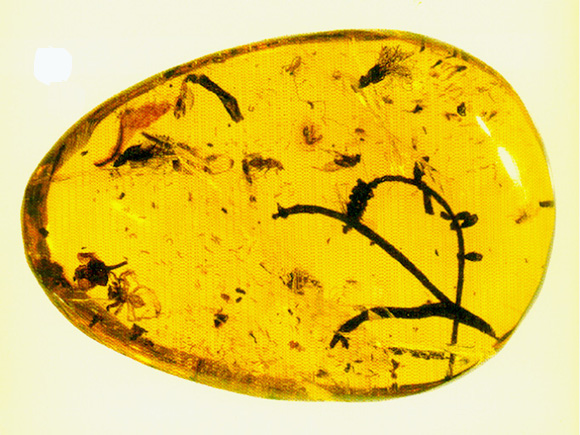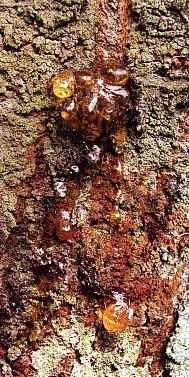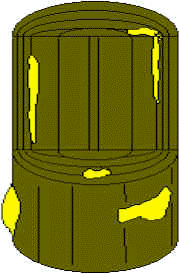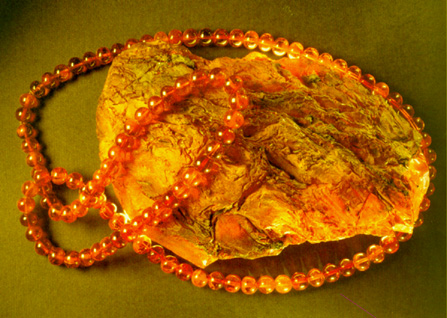
Amber
One of
Nature's Jewels

Ever seen an egg like this one? They are rare and precious, as this one contains a menagerie of at least 217 insects, spiders and small plant fragments. The most abundant tiny insects visible are called springtails. Plant fragments came from an acacia tree.
|
Jurassic Park |
 Amber,
fossil resin that, in prehistoric times, exuded from various
now-extinct coniferous trees. It is usually a yellow or yellow-brown
color. Found in either round, irregular lumps, grains, or drops, it
is slightly brittle and emits an agreeable odor when rubbed. Amber
burns with a bright flame and pleasant smell and becomes negatively
electric by friction. Extinct and existing species of insects are
sometimes found encased in samples of amber. It was obtained in
antiquity from the southern coast of the Baltic Sea, where it is
still found. It is also found in small quantities in Sicily, Romania,
Siberia, Greenland, Myanmar (formerly known as Burma), Australia, and
the United States.
Amber,
fossil resin that, in prehistoric times, exuded from various
now-extinct coniferous trees. It is usually a yellow or yellow-brown
color. Found in either round, irregular lumps, grains, or drops, it
is slightly brittle and emits an agreeable odor when rubbed. Amber
burns with a bright flame and pleasant smell and becomes negatively
electric by friction. Extinct and existing species of insects are
sometimes found encased in samples of amber. It was obtained in
antiquity from the southern coast of the Baltic Sea, where it is
still found. It is also found in small quantities in Sicily, Romania,
Siberia, Greenland, Myanmar (formerly known as Burma), Australia, and
the United States.
Amber is the ancient resin of trees. The resin has gone through a number of changes over millions of years. The result of this metamorphosis is an exceptional gem with extraordinary properties. It is exploited and used by both craftsmen and scientist.
It is probably only from the Carboniferous past that land based plant species evolved capable of producing resin which subsequently turned into amber. From that time on various tree species have produced different deposits of amber.
Tree Sources
The worlds two current major deposits of amber; Dominican Republic and Baltic had two separate tree types which produced the original resin. The Baltic source tree has been named Pinites succinifer. In appearance it would have probably resembled a pine or spruce tree and the forests in which it grew were sub tropical in nature. It may not have looked unfamiliar today. Here a photograph of a fir and spruce forest may well give a good indication of what the Baltic amber forest would have looked like.
From amongst the numerous inclusions found in Baltic amber other trees species have been identified as being present. Here are just some of the trees that must have grown in the ancient amber forest:
The reason for the exudation of the resin from various species of trees is not fully understood. Research suggests one of five reasons:
A defense mechanism against fungal or insect attack;
Of these 5 processes the world's major amber deposits are most likely to be a product of insect or fungal assault. Amber therefore could be a reaction to attack from external forces. For example, an insect bores a hole into a branch or twig and a stream of resin is exuded to prevent further intrusion and to repair and reinforce the damage done.
Seasonal growth may also induce a flux of resin into the plant at certain times of year. Research has been undertaken which analyzed inclusions that would indicate at what time of the year the fresh resin had been produced. The result of this research centered mostly on the presence of stellate hairs. Stellate hairs are a product of the oak trees and are produced predominantly during the spring and early summer, the results of this work indicated that up to 60% of the Baltic amber would have been fresh at the time these inclusions were trapped.
 It
is a common misconception that resin was only vented onto the tree's
external surfaces; branches, trunk and surface roots, as in the
picture of a cherry tree trunk (to the left). Resin was in fact also
exuded within the tree its self forming moats or channels of
hardening resin within the wood matrix. What the purpose of these
formations were for is unknown. It might be speculated that it was a
reaction in some cases to termite or wood boring insect attack?
It
is a common misconception that resin was only vented onto the tree's
external surfaces; branches, trunk and surface roots, as in the
picture of a cherry tree trunk (to the left). Resin was in fact also
exuded within the tree its self forming moats or channels of
hardening resin within the wood matrix. What the purpose of these
formations were for is unknown. It might be speculated that it was a
reaction in some cases to termite or wood boring insect attack?
The diagram at the right shows a cut away tree trunk with typical
amber channels and pools which formed within the trunks or branches as well as on their surfaces. Each of
these resins formed by the tree had a unique chemical constituency
and was not uniform in nature.
within the trunks or branches as well as on their surfaces. Each of
these resins formed by the tree had a unique chemical constituency
and was not uniform in nature.
The resin was formed in resin canals or ducts within the wood itself. It is not part of the trees sap, which is a watery substance containing complex sugars. Specialist cells which form the resin are distributed throughout the body of the tree itself.Two resin products with fame of "biblical" proportions are frankincense and myrrh, two of the Magi gifts to the Christ child. Frankincense comes from 3 species of Boswellia: carteril, papyrifera, and thurifera. The finest known is Arabian and was formerly transported by camel caravans thru Palestine and Egypt, all the way to Greece and then Rome. Around 200 A.D., merchants were shipping over 3,000 tons per year, most of this headed for Rome.
Good for several purposes

Myrrh comes from Commifera trees and has been used as perfume base, oils for Hebrew annointing rituals, and for incense in cremations. As an embalming agent, ancient Egyptians poured the concoction of resins, gums and oils into the cranial, chest, abdominal, and pelvic cavities of bodies to be mummified. Resin has a dehydrating as well as preservative property. Bandages were soaked in it to wrap the bodies. Apparantly this has worked, as evidenced by the condition of bodies found after many thousands of years. Egyptians also derived sandrac and mastic from resins, two chemicals used in paint pigments for ceramic jars and art on the walls of tombs. Artisans used resin to harden oil paints and coat their paintings with a protective cover of liquid dammar (generic Malay word for all resin, but generally refers to Southeast Asia).
Frankincense, name applied to various gum resins, containing volatile oils, that diffuse a strong fragrance in burning. Oriental frankincense, also known as olibanum, was esteemed by ancient peoples for use in embalming and as incense and is still the most important incense resin. It is obtained from several Oriental trees that grow in northeastern Africa and Arabia. The hardened, semitransparent yellowish material is still used widely as ceremonial incense. Common frankincense is obtained from the bark of the Norway spruce. When boiled in water and strained, the resin becomes Burgundy pitch, formerly used in making medicinal plasters.
Two great web sites with great information and pictures of amber.
http://www.uky.edu/ArtsSciences/Geology/webdogs/amber/welcome.html
http://www.gplatt.demon.co.uk/whatis.htm